Strategic Management Report: Dalata Hotels' Dubai Strategy Analysis
VerifiedAdded on 2021/04/19
|15
|4461
|47
Report
AI Summary
This report presents a strategic management analysis focused on the potential expansion of Dalata Hotels into Dubai. It begins with an executive summary and an introduction to strategic business development. The main body of the report includes a comprehensive PESTLE analysis, examining the political, economic, social, technological, ecological, and legal factors influencing the hotel industry in Dubai. It also delves into the competitive environment, applying Porter's Five Forces to assess barriers to entry, the threat of substitutes, bargaining power of buyers and sellers, and the rivalry among existing competitors. An internal analysis assesses Dalata's strategic capabilities, including resource audits and core competencies. The report then outlines various competitive strategies and concludes with recommendations for Dalata's entry into the Dubai market, emphasizing the importance of value addition and competitive pricing. The report references various sources and includes appendices.
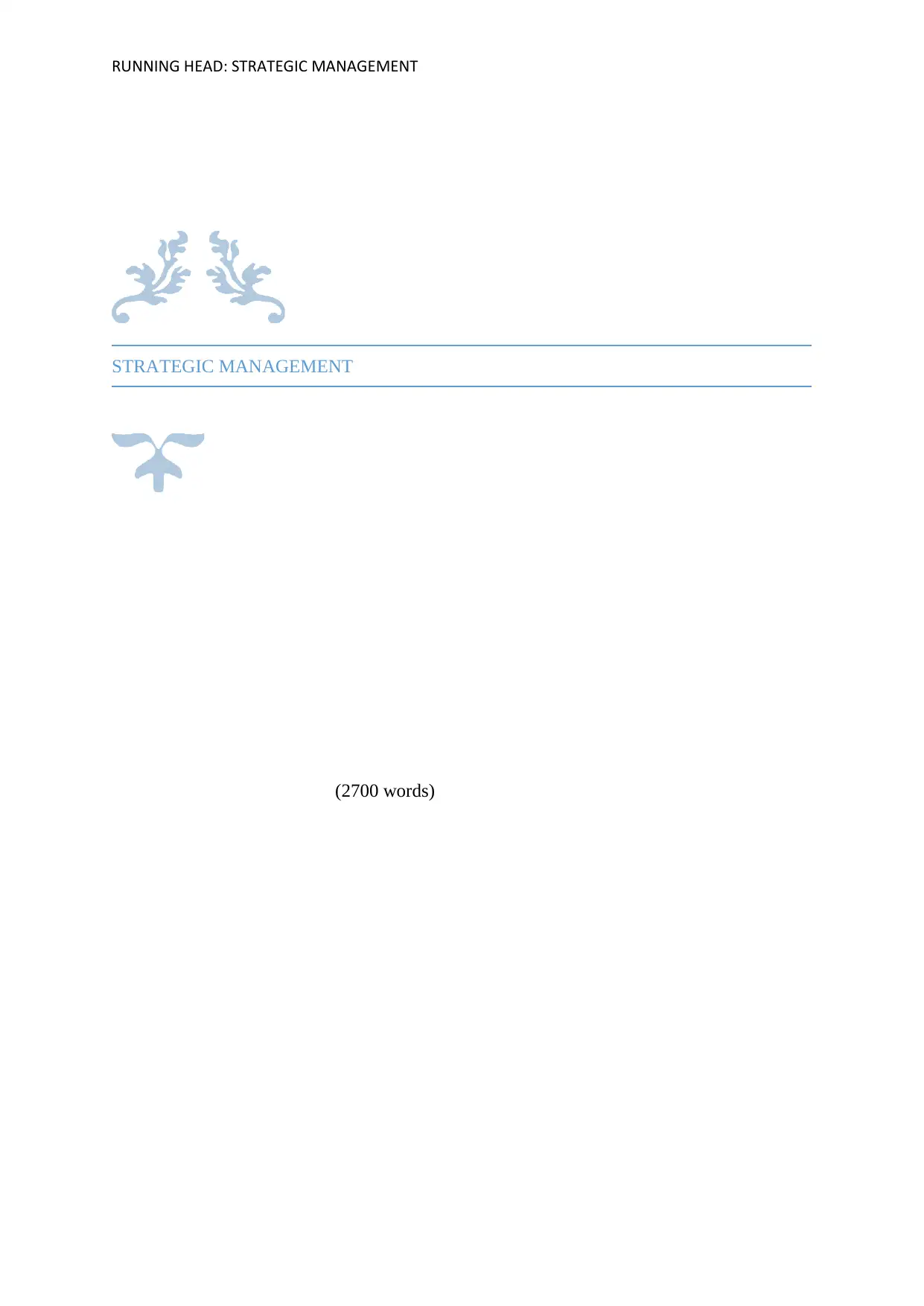
RUNNING HEAD: STRATEGIC MANAGEMENT
STRATEGIC MANAGEMENT
(2700 words)
STRATEGIC MANAGEMENT
(2700 words)
Paraphrase This Document
Need a fresh take? Get an instant paraphrase of this document with our AI Paraphraser
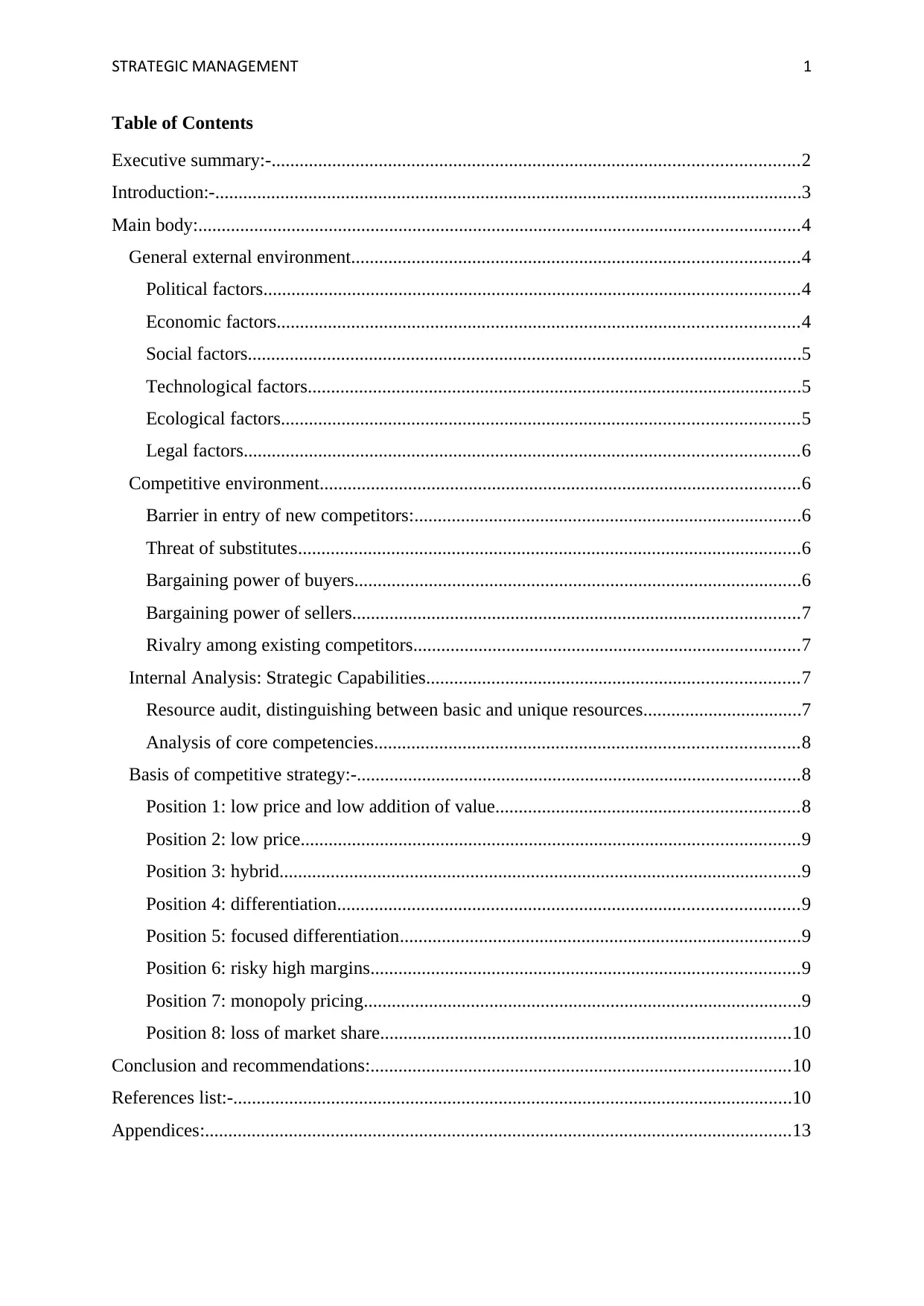
STRATEGIC MANAGEMENT 1
Table of Contents
Executive summary:-.................................................................................................................2
Introduction:-..............................................................................................................................3
Main body:.................................................................................................................................4
General external environment................................................................................................4
Political factors...................................................................................................................4
Economic factors................................................................................................................4
Social factors.......................................................................................................................5
Technological factors..........................................................................................................5
Ecological factors...............................................................................................................5
Legal factors.......................................................................................................................6
Competitive environment.......................................................................................................6
Barrier in entry of new competitors:...................................................................................6
Threat of substitutes............................................................................................................6
Bargaining power of buyers................................................................................................6
Bargaining power of sellers................................................................................................7
Rivalry among existing competitors...................................................................................7
Internal Analysis: Strategic Capabilities................................................................................7
Resource audit, distinguishing between basic and unique resources..................................7
Analysis of core competencies...........................................................................................8
Basis of competitive strategy:-...............................................................................................8
Position 1: low price and low addition of value.................................................................8
Position 2: low price...........................................................................................................9
Position 3: hybrid................................................................................................................9
Position 4: differentiation...................................................................................................9
Position 5: focused differentiation......................................................................................9
Position 6: risky high margins............................................................................................9
Position 7: monopoly pricing..............................................................................................9
Position 8: loss of market share........................................................................................10
Conclusion and recommendations:..........................................................................................10
References list:-........................................................................................................................10
Appendices:..............................................................................................................................13
Table of Contents
Executive summary:-.................................................................................................................2
Introduction:-..............................................................................................................................3
Main body:.................................................................................................................................4
General external environment................................................................................................4
Political factors...................................................................................................................4
Economic factors................................................................................................................4
Social factors.......................................................................................................................5
Technological factors..........................................................................................................5
Ecological factors...............................................................................................................5
Legal factors.......................................................................................................................6
Competitive environment.......................................................................................................6
Barrier in entry of new competitors:...................................................................................6
Threat of substitutes............................................................................................................6
Bargaining power of buyers................................................................................................6
Bargaining power of sellers................................................................................................7
Rivalry among existing competitors...................................................................................7
Internal Analysis: Strategic Capabilities................................................................................7
Resource audit, distinguishing between basic and unique resources..................................7
Analysis of core competencies...........................................................................................8
Basis of competitive strategy:-...............................................................................................8
Position 1: low price and low addition of value.................................................................8
Position 2: low price...........................................................................................................9
Position 3: hybrid................................................................................................................9
Position 4: differentiation...................................................................................................9
Position 5: focused differentiation......................................................................................9
Position 6: risky high margins............................................................................................9
Position 7: monopoly pricing..............................................................................................9
Position 8: loss of market share........................................................................................10
Conclusion and recommendations:..........................................................................................10
References list:-........................................................................................................................10
Appendices:..............................................................................................................................13
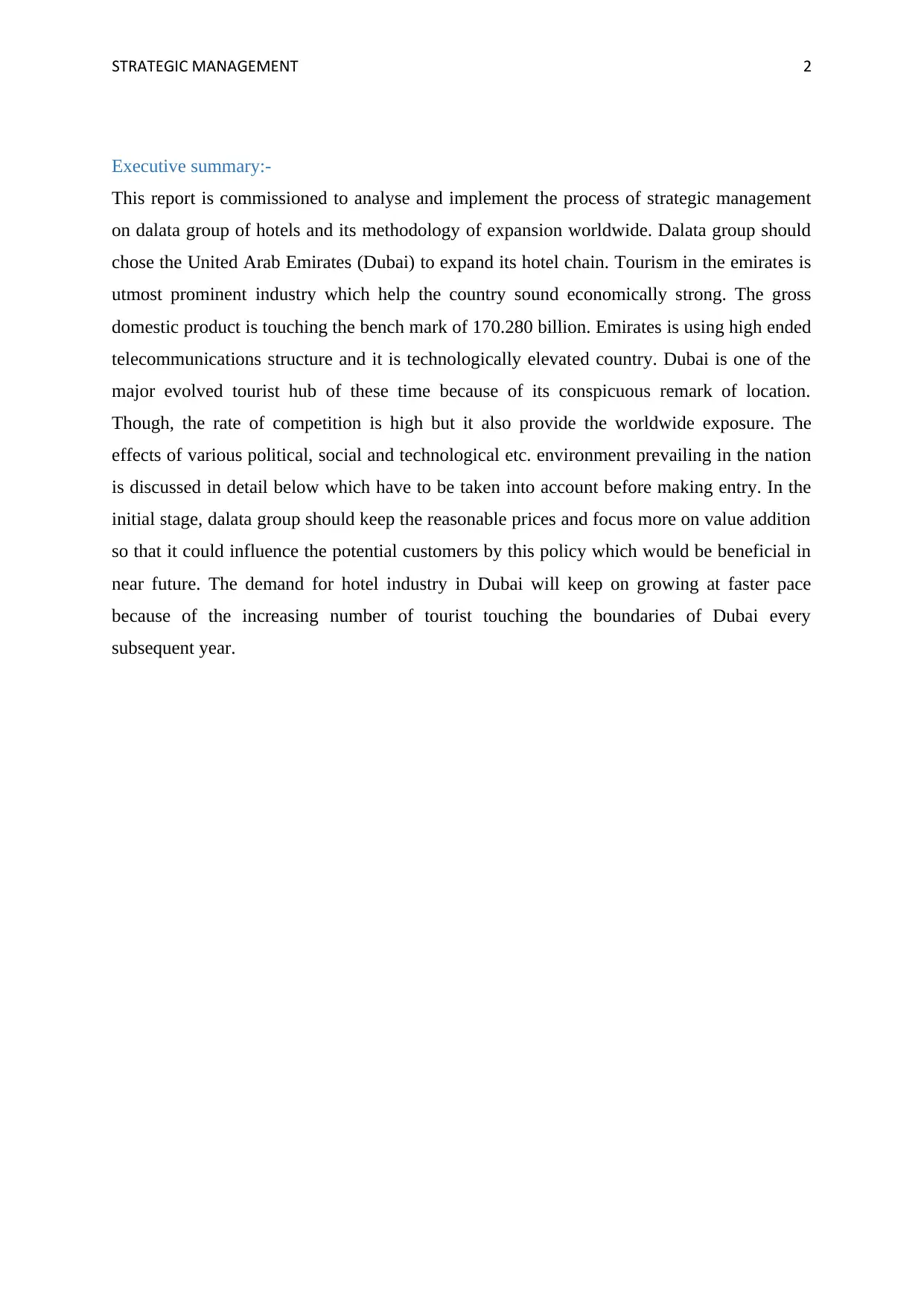
STRATEGIC MANAGEMENT 2
Executive summary:-
This report is commissioned to analyse and implement the process of strategic management
on dalata group of hotels and its methodology of expansion worldwide. Dalata group should
chose the United Arab Emirates (Dubai) to expand its hotel chain. Tourism in the emirates is
utmost prominent industry which help the country sound economically strong. The gross
domestic product is touching the bench mark of 170.280 billion. Emirates is using high ended
telecommunications structure and it is technologically elevated country. Dubai is one of the
major evolved tourist hub of these time because of its conspicuous remark of location.
Though, the rate of competition is high but it also provide the worldwide exposure. The
effects of various political, social and technological etc. environment prevailing in the nation
is discussed in detail below which have to be taken into account before making entry. In the
initial stage, dalata group should keep the reasonable prices and focus more on value addition
so that it could influence the potential customers by this policy which would be beneficial in
near future. The demand for hotel industry in Dubai will keep on growing at faster pace
because of the increasing number of tourist touching the boundaries of Dubai every
subsequent year.
Executive summary:-
This report is commissioned to analyse and implement the process of strategic management
on dalata group of hotels and its methodology of expansion worldwide. Dalata group should
chose the United Arab Emirates (Dubai) to expand its hotel chain. Tourism in the emirates is
utmost prominent industry which help the country sound economically strong. The gross
domestic product is touching the bench mark of 170.280 billion. Emirates is using high ended
telecommunications structure and it is technologically elevated country. Dubai is one of the
major evolved tourist hub of these time because of its conspicuous remark of location.
Though, the rate of competition is high but it also provide the worldwide exposure. The
effects of various political, social and technological etc. environment prevailing in the nation
is discussed in detail below which have to be taken into account before making entry. In the
initial stage, dalata group should keep the reasonable prices and focus more on value addition
so that it could influence the potential customers by this policy which would be beneficial in
near future. The demand for hotel industry in Dubai will keep on growing at faster pace
because of the increasing number of tourist touching the boundaries of Dubai every
subsequent year.
⊘ This is a preview!⊘
Do you want full access?
Subscribe today to unlock all pages.

Trusted by 1+ million students worldwide
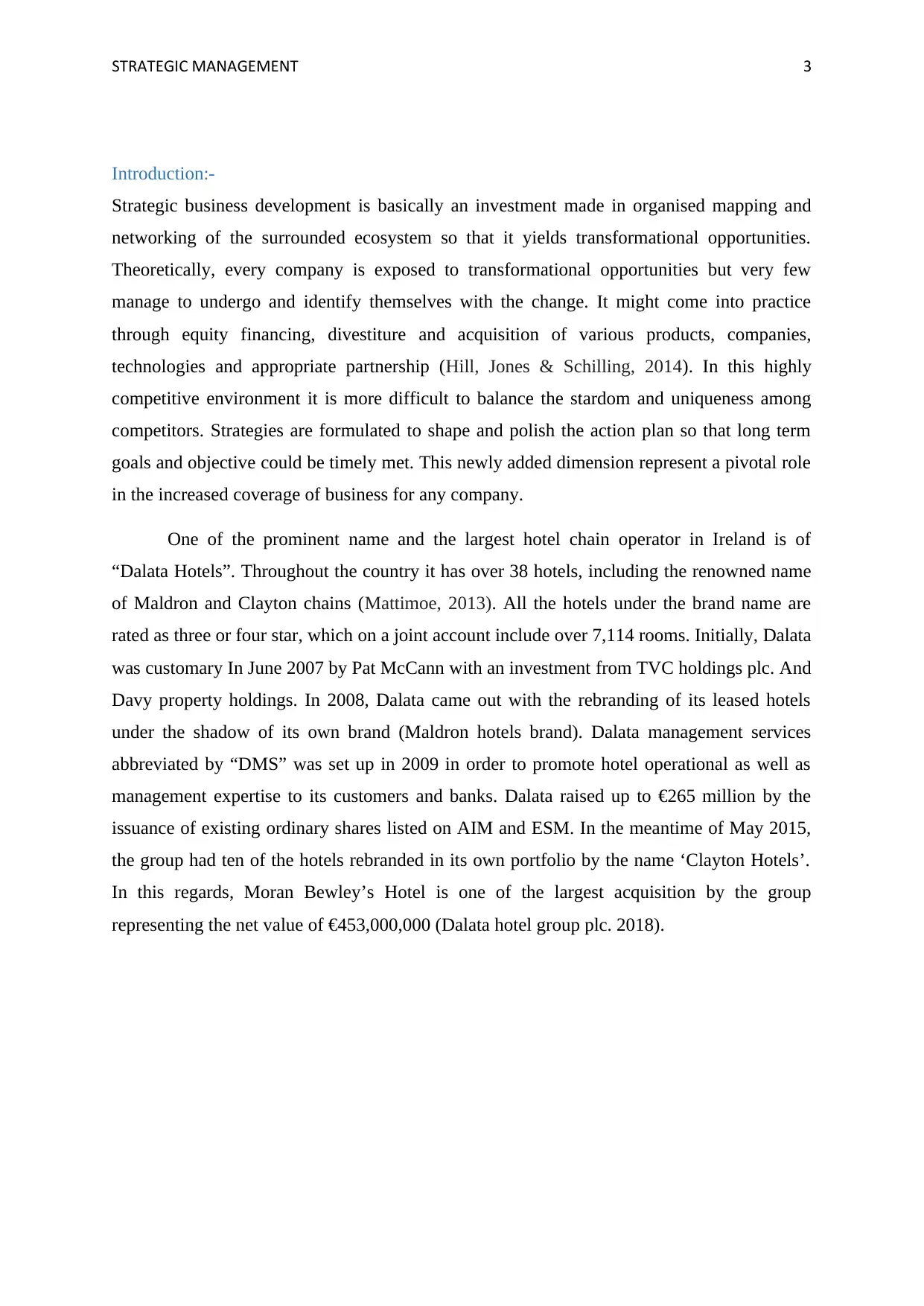
STRATEGIC MANAGEMENT 3
Introduction:-
Strategic business development is basically an investment made in organised mapping and
networking of the surrounded ecosystem so that it yields transformational opportunities.
Theoretically, every company is exposed to transformational opportunities but very few
manage to undergo and identify themselves with the change. It might come into practice
through equity financing, divestiture and acquisition of various products, companies,
technologies and appropriate partnership (Hill, Jones & Schilling, 2014). In this highly
competitive environment it is more difficult to balance the stardom and uniqueness among
competitors. Strategies are formulated to shape and polish the action plan so that long term
goals and objective could be timely met. This newly added dimension represent a pivotal role
in the increased coverage of business for any company.
One of the prominent name and the largest hotel chain operator in Ireland is of
“Dalata Hotels”. Throughout the country it has over 38 hotels, including the renowned name
of Maldron and Clayton chains (Mattimoe, 2013). All the hotels under the brand name are
rated as three or four star, which on a joint account include over 7,114 rooms. Initially, Dalata
was customary In June 2007 by Pat McCann with an investment from TVC holdings plc. And
Davy property holdings. In 2008, Dalata came out with the rebranding of its leased hotels
under the shadow of its own brand (Maldron hotels brand). Dalata management services
abbreviated by “DMS” was set up in 2009 in order to promote hotel operational as well as
management expertise to its customers and banks. Dalata raised up to €265 million by the
issuance of existing ordinary shares listed on AIM and ESM. In the meantime of May 2015,
the group had ten of the hotels rebranded in its own portfolio by the name ‘Clayton Hotels’.
In this regards, Moran Bewley’s Hotel is one of the largest acquisition by the group
representing the net value of €453,000,000 (Dalata hotel group plc. 2018).
Introduction:-
Strategic business development is basically an investment made in organised mapping and
networking of the surrounded ecosystem so that it yields transformational opportunities.
Theoretically, every company is exposed to transformational opportunities but very few
manage to undergo and identify themselves with the change. It might come into practice
through equity financing, divestiture and acquisition of various products, companies,
technologies and appropriate partnership (Hill, Jones & Schilling, 2014). In this highly
competitive environment it is more difficult to balance the stardom and uniqueness among
competitors. Strategies are formulated to shape and polish the action plan so that long term
goals and objective could be timely met. This newly added dimension represent a pivotal role
in the increased coverage of business for any company.
One of the prominent name and the largest hotel chain operator in Ireland is of
“Dalata Hotels”. Throughout the country it has over 38 hotels, including the renowned name
of Maldron and Clayton chains (Mattimoe, 2013). All the hotels under the brand name are
rated as three or four star, which on a joint account include over 7,114 rooms. Initially, Dalata
was customary In June 2007 by Pat McCann with an investment from TVC holdings plc. And
Davy property holdings. In 2008, Dalata came out with the rebranding of its leased hotels
under the shadow of its own brand (Maldron hotels brand). Dalata management services
abbreviated by “DMS” was set up in 2009 in order to promote hotel operational as well as
management expertise to its customers and banks. Dalata raised up to €265 million by the
issuance of existing ordinary shares listed on AIM and ESM. In the meantime of May 2015,
the group had ten of the hotels rebranded in its own portfolio by the name ‘Clayton Hotels’.
In this regards, Moran Bewley’s Hotel is one of the largest acquisition by the group
representing the net value of €453,000,000 (Dalata hotel group plc. 2018).
Paraphrase This Document
Need a fresh take? Get an instant paraphrase of this document with our AI Paraphraser
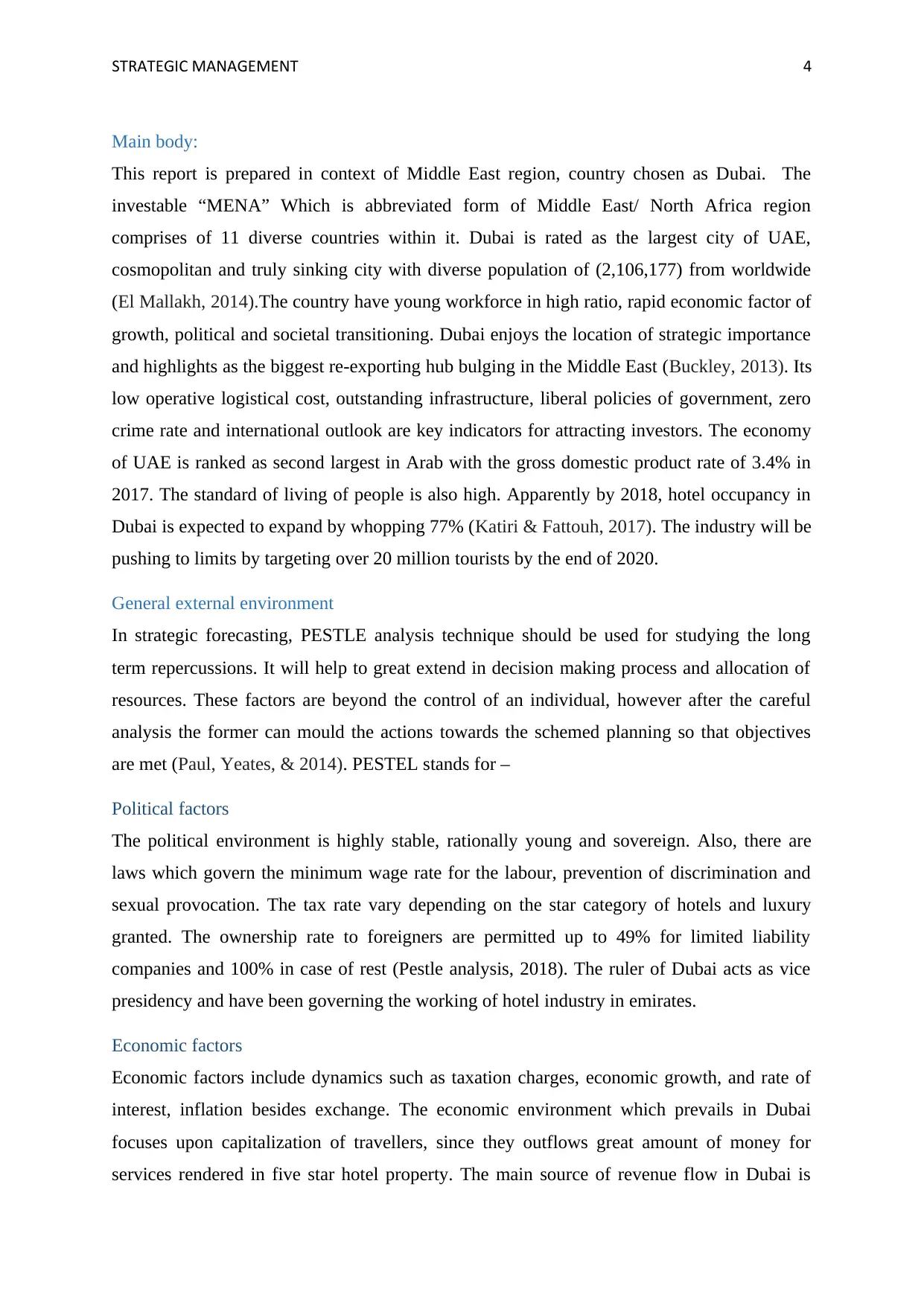
STRATEGIC MANAGEMENT 4
Main body:
This report is prepared in context of Middle East region, country chosen as Dubai. The
investable “MENA” Which is abbreviated form of Middle East/ North Africa region
comprises of 11 diverse countries within it. Dubai is rated as the largest city of UAE,
cosmopolitan and truly sinking city with diverse population of (2,106,177) from worldwide
(El Mallakh, 2014).The country have young workforce in high ratio, rapid economic factor of
growth, political and societal transitioning. Dubai enjoys the location of strategic importance
and highlights as the biggest re-exporting hub bulging in the Middle East (Buckley, 2013). Its
low operative logistical cost, outstanding infrastructure, liberal policies of government, zero
crime rate and international outlook are key indicators for attracting investors. The economy
of UAE is ranked as second largest in Arab with the gross domestic product rate of 3.4% in
2017. The standard of living of people is also high. Apparently by 2018, hotel occupancy in
Dubai is expected to expand by whopping 77% (Katiri & Fattouh, 2017). The industry will be
pushing to limits by targeting over 20 million tourists by the end of 2020.
General external environment
In strategic forecasting, PESTLE analysis technique should be used for studying the long
term repercussions. It will help to great extend in decision making process and allocation of
resources. These factors are beyond the control of an individual, however after the careful
analysis the former can mould the actions towards the schemed planning so that objectives
are met (Paul, Yeates, & 2014). PESTEL stands for –
Political factors
The political environment is highly stable, rationally young and sovereign. Also, there are
laws which govern the minimum wage rate for the labour, prevention of discrimination and
sexual provocation. The tax rate vary depending on the star category of hotels and luxury
granted. The ownership rate to foreigners are permitted up to 49% for limited liability
companies and 100% in case of rest (Pestle analysis, 2018). The ruler of Dubai acts as vice
presidency and have been governing the working of hotel industry in emirates.
Economic factors
Economic factors include dynamics such as taxation charges, economic growth, and rate of
interest, inflation besides exchange. The economic environment which prevails in Dubai
focuses upon capitalization of travellers, since they outflows great amount of money for
services rendered in five star hotel property. The main source of revenue flow in Dubai is
Main body:
This report is prepared in context of Middle East region, country chosen as Dubai. The
investable “MENA” Which is abbreviated form of Middle East/ North Africa region
comprises of 11 diverse countries within it. Dubai is rated as the largest city of UAE,
cosmopolitan and truly sinking city with diverse population of (2,106,177) from worldwide
(El Mallakh, 2014).The country have young workforce in high ratio, rapid economic factor of
growth, political and societal transitioning. Dubai enjoys the location of strategic importance
and highlights as the biggest re-exporting hub bulging in the Middle East (Buckley, 2013). Its
low operative logistical cost, outstanding infrastructure, liberal policies of government, zero
crime rate and international outlook are key indicators for attracting investors. The economy
of UAE is ranked as second largest in Arab with the gross domestic product rate of 3.4% in
2017. The standard of living of people is also high. Apparently by 2018, hotel occupancy in
Dubai is expected to expand by whopping 77% (Katiri & Fattouh, 2017). The industry will be
pushing to limits by targeting over 20 million tourists by the end of 2020.
General external environment
In strategic forecasting, PESTLE analysis technique should be used for studying the long
term repercussions. It will help to great extend in decision making process and allocation of
resources. These factors are beyond the control of an individual, however after the careful
analysis the former can mould the actions towards the schemed planning so that objectives
are met (Paul, Yeates, & 2014). PESTEL stands for –
Political factors
The political environment is highly stable, rationally young and sovereign. Also, there are
laws which govern the minimum wage rate for the labour, prevention of discrimination and
sexual provocation. The tax rate vary depending on the star category of hotels and luxury
granted. The ownership rate to foreigners are permitted up to 49% for limited liability
companies and 100% in case of rest (Pestle analysis, 2018). The ruler of Dubai acts as vice
presidency and have been governing the working of hotel industry in emirates.
Economic factors
Economic factors include dynamics such as taxation charges, economic growth, and rate of
interest, inflation besides exchange. The economic environment which prevails in Dubai
focuses upon capitalization of travellers, since they outflows great amount of money for
services rendered in five star hotel property. The main source of revenue flow in Dubai is
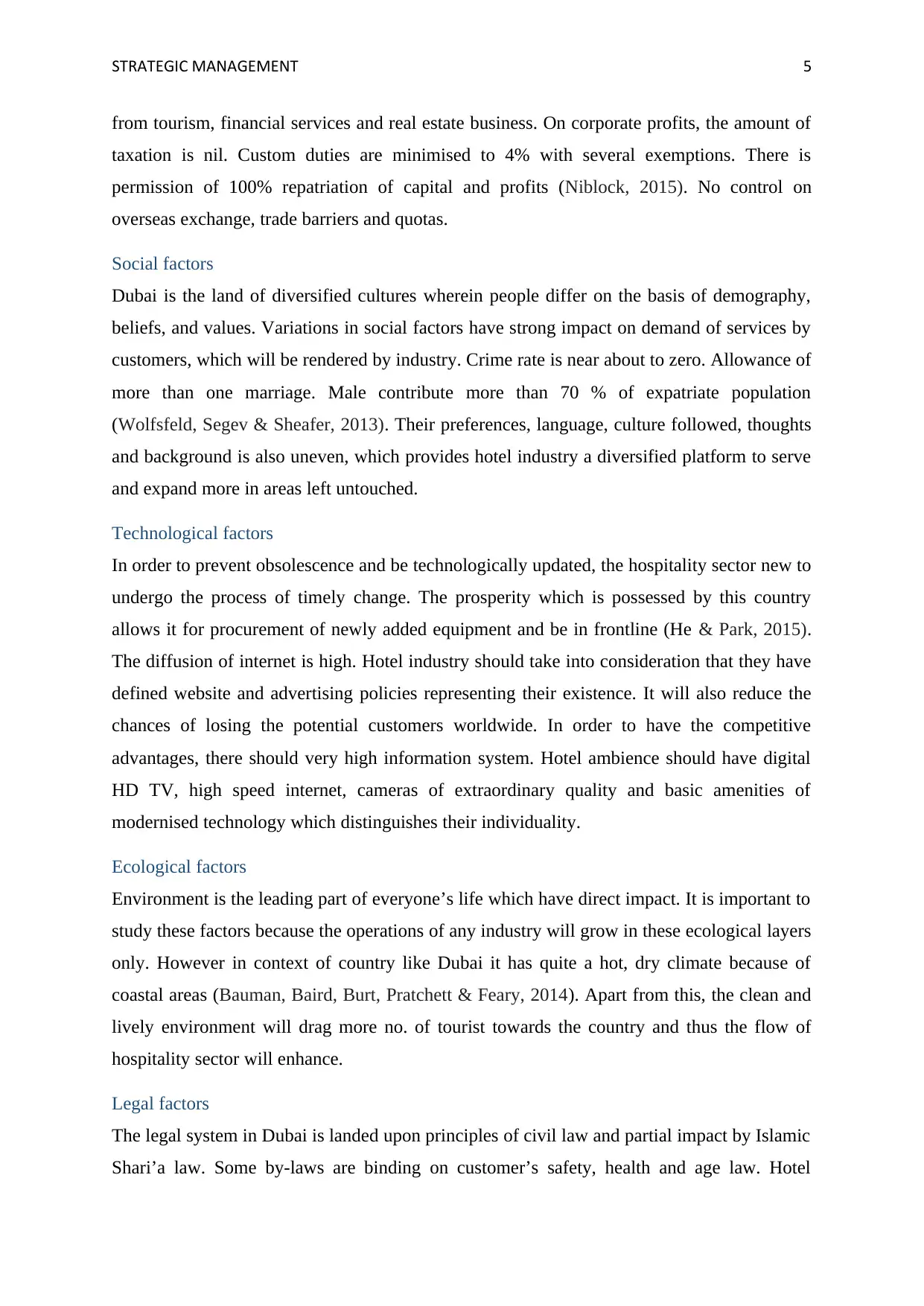
STRATEGIC MANAGEMENT 5
from tourism, financial services and real estate business. On corporate profits, the amount of
taxation is nil. Custom duties are minimised to 4% with several exemptions. There is
permission of 100% repatriation of capital and profits (Niblock, 2015). No control on
overseas exchange, trade barriers and quotas.
Social factors
Dubai is the land of diversified cultures wherein people differ on the basis of demography,
beliefs, and values. Variations in social factors have strong impact on demand of services by
customers, which will be rendered by industry. Crime rate is near about to zero. Allowance of
more than one marriage. Male contribute more than 70 % of expatriate population
(Wolfsfeld, Segev & Sheafer, 2013). Their preferences, language, culture followed, thoughts
and background is also uneven, which provides hotel industry a diversified platform to serve
and expand more in areas left untouched.
Technological factors
In order to prevent obsolescence and be technologically updated, the hospitality sector new to
undergo the process of timely change. The prosperity which is possessed by this country
allows it for procurement of newly added equipment and be in frontline (He & Park, 2015).
The diffusion of internet is high. Hotel industry should take into consideration that they have
defined website and advertising policies representing their existence. It will also reduce the
chances of losing the potential customers worldwide. In order to have the competitive
advantages, there should very high information system. Hotel ambience should have digital
HD TV, high speed internet, cameras of extraordinary quality and basic amenities of
modernised technology which distinguishes their individuality.
Ecological factors
Environment is the leading part of everyone’s life which have direct impact. It is important to
study these factors because the operations of any industry will grow in these ecological layers
only. However in context of country like Dubai it has quite a hot, dry climate because of
coastal areas (Bauman, Baird, Burt, Pratchett & Feary, 2014). Apart from this, the clean and
lively environment will drag more no. of tourist towards the country and thus the flow of
hospitality sector will enhance.
Legal factors
The legal system in Dubai is landed upon principles of civil law and partial impact by Islamic
Shari’a law. Some by-laws are binding on customer’s safety, health and age law. Hotel
from tourism, financial services and real estate business. On corporate profits, the amount of
taxation is nil. Custom duties are minimised to 4% with several exemptions. There is
permission of 100% repatriation of capital and profits (Niblock, 2015). No control on
overseas exchange, trade barriers and quotas.
Social factors
Dubai is the land of diversified cultures wherein people differ on the basis of demography,
beliefs, and values. Variations in social factors have strong impact on demand of services by
customers, which will be rendered by industry. Crime rate is near about to zero. Allowance of
more than one marriage. Male contribute more than 70 % of expatriate population
(Wolfsfeld, Segev & Sheafer, 2013). Their preferences, language, culture followed, thoughts
and background is also uneven, which provides hotel industry a diversified platform to serve
and expand more in areas left untouched.
Technological factors
In order to prevent obsolescence and be technologically updated, the hospitality sector new to
undergo the process of timely change. The prosperity which is possessed by this country
allows it for procurement of newly added equipment and be in frontline (He & Park, 2015).
The diffusion of internet is high. Hotel industry should take into consideration that they have
defined website and advertising policies representing their existence. It will also reduce the
chances of losing the potential customers worldwide. In order to have the competitive
advantages, there should very high information system. Hotel ambience should have digital
HD TV, high speed internet, cameras of extraordinary quality and basic amenities of
modernised technology which distinguishes their individuality.
Ecological factors
Environment is the leading part of everyone’s life which have direct impact. It is important to
study these factors because the operations of any industry will grow in these ecological layers
only. However in context of country like Dubai it has quite a hot, dry climate because of
coastal areas (Bauman, Baird, Burt, Pratchett & Feary, 2014). Apart from this, the clean and
lively environment will drag more no. of tourist towards the country and thus the flow of
hospitality sector will enhance.
Legal factors
The legal system in Dubai is landed upon principles of civil law and partial impact by Islamic
Shari’a law. Some by-laws are binding on customer’s safety, health and age law. Hotel
⊘ This is a preview!⊘
Do you want full access?
Subscribe today to unlock all pages.

Trusted by 1+ million students worldwide
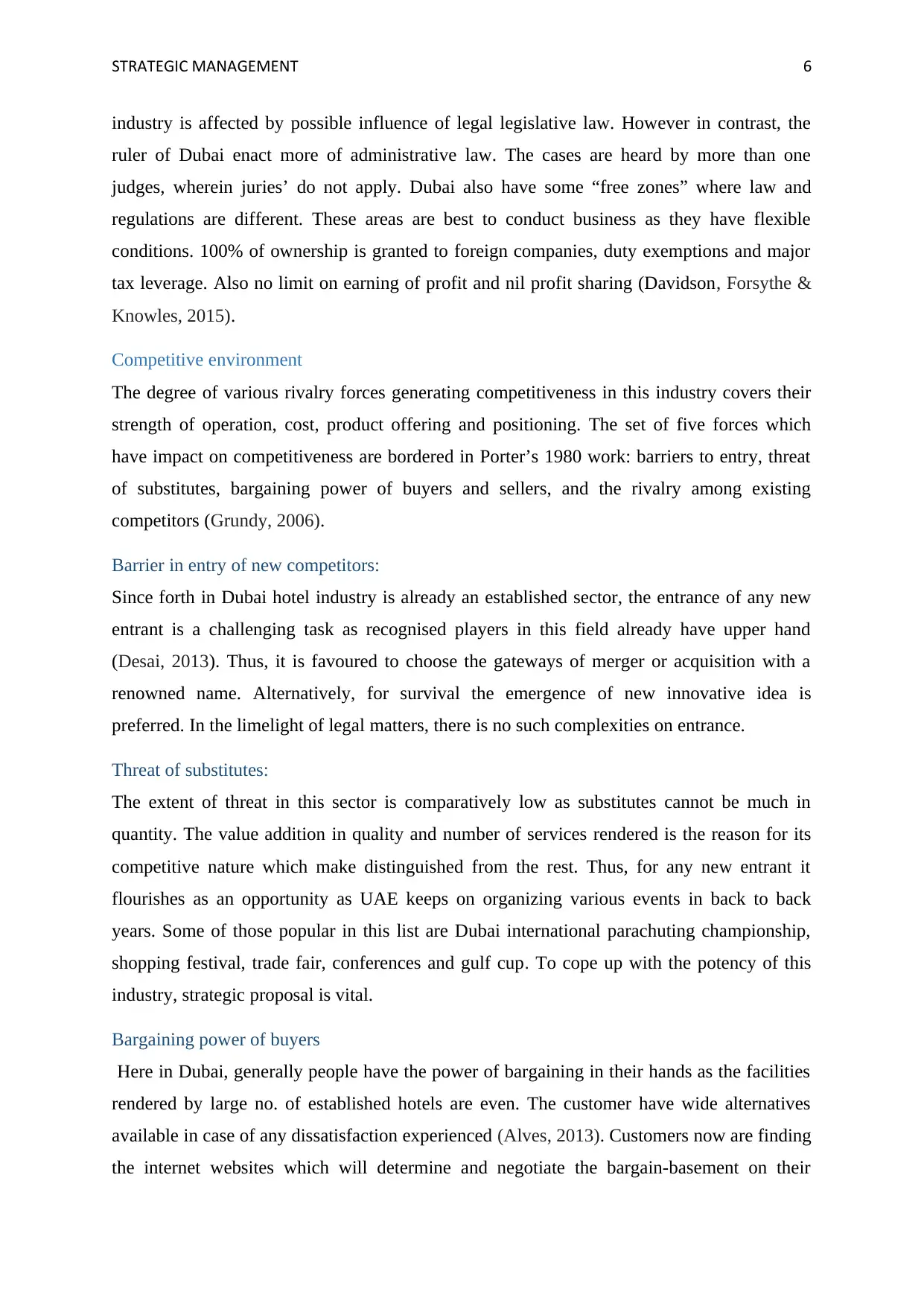
STRATEGIC MANAGEMENT 6
industry is affected by possible influence of legal legislative law. However in contrast, the
ruler of Dubai enact more of administrative law. The cases are heard by more than one
judges, wherein juries’ do not apply. Dubai also have some “free zones” where law and
regulations are different. These areas are best to conduct business as they have flexible
conditions. 100% of ownership is granted to foreign companies, duty exemptions and major
tax leverage. Also no limit on earning of profit and nil profit sharing (Davidson, Forsythe &
Knowles, 2015).
Competitive environment
The degree of various rivalry forces generating competitiveness in this industry covers their
strength of operation, cost, product offering and positioning. The set of five forces which
have impact on competitiveness are bordered in Porter’s 1980 work: barriers to entry, threat
of substitutes, bargaining power of buyers and sellers, and the rivalry among existing
competitors (Grundy, 2006).
Barrier in entry of new competitors:
Since forth in Dubai hotel industry is already an established sector, the entrance of any new
entrant is a challenging task as recognised players in this field already have upper hand
(Desai, 2013). Thus, it is favoured to choose the gateways of merger or acquisition with a
renowned name. Alternatively, for survival the emergence of new innovative idea is
preferred. In the limelight of legal matters, there is no such complexities on entrance.
Threat of substitutes:
The extent of threat in this sector is comparatively low as substitutes cannot be much in
quantity. The value addition in quality and number of services rendered is the reason for its
competitive nature which make distinguished from the rest. Thus, for any new entrant it
flourishes as an opportunity as UAE keeps on organizing various events in back to back
years. Some of those popular in this list are Dubai international parachuting championship,
shopping festival, trade fair, conferences and gulf cup. To cope up with the potency of this
industry, strategic proposal is vital.
Bargaining power of buyers
Here in Dubai, generally people have the power of bargaining in their hands as the facilities
rendered by large no. of established hotels are even. The customer have wide alternatives
available in case of any dissatisfaction experienced (Alves, 2013). Customers now are finding
the internet websites which will determine and negotiate the bargain-basement on their
industry is affected by possible influence of legal legislative law. However in contrast, the
ruler of Dubai enact more of administrative law. The cases are heard by more than one
judges, wherein juries’ do not apply. Dubai also have some “free zones” where law and
regulations are different. These areas are best to conduct business as they have flexible
conditions. 100% of ownership is granted to foreign companies, duty exemptions and major
tax leverage. Also no limit on earning of profit and nil profit sharing (Davidson, Forsythe &
Knowles, 2015).
Competitive environment
The degree of various rivalry forces generating competitiveness in this industry covers their
strength of operation, cost, product offering and positioning. The set of five forces which
have impact on competitiveness are bordered in Porter’s 1980 work: barriers to entry, threat
of substitutes, bargaining power of buyers and sellers, and the rivalry among existing
competitors (Grundy, 2006).
Barrier in entry of new competitors:
Since forth in Dubai hotel industry is already an established sector, the entrance of any new
entrant is a challenging task as recognised players in this field already have upper hand
(Desai, 2013). Thus, it is favoured to choose the gateways of merger or acquisition with a
renowned name. Alternatively, for survival the emergence of new innovative idea is
preferred. In the limelight of legal matters, there is no such complexities on entrance.
Threat of substitutes:
The extent of threat in this sector is comparatively low as substitutes cannot be much in
quantity. The value addition in quality and number of services rendered is the reason for its
competitive nature which make distinguished from the rest. Thus, for any new entrant it
flourishes as an opportunity as UAE keeps on organizing various events in back to back
years. Some of those popular in this list are Dubai international parachuting championship,
shopping festival, trade fair, conferences and gulf cup. To cope up with the potency of this
industry, strategic proposal is vital.
Bargaining power of buyers
Here in Dubai, generally people have the power of bargaining in their hands as the facilities
rendered by large no. of established hotels are even. The customer have wide alternatives
available in case of any dissatisfaction experienced (Alves, 2013). Customers now are finding
the internet websites which will determine and negotiate the bargain-basement on their
Paraphrase This Document
Need a fresh take? Get an instant paraphrase of this document with our AI Paraphraser
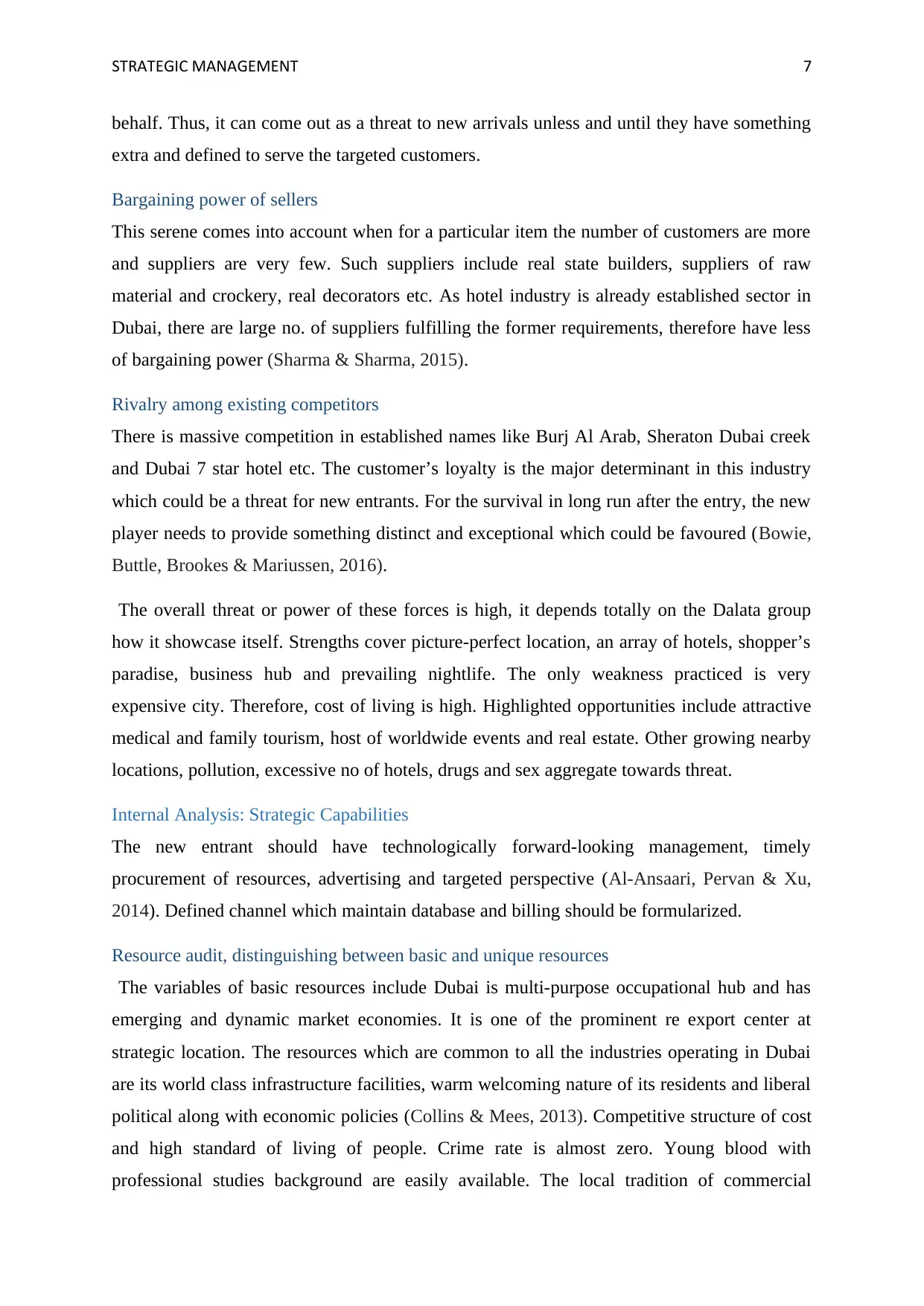
STRATEGIC MANAGEMENT 7
behalf. Thus, it can come out as a threat to new arrivals unless and until they have something
extra and defined to serve the targeted customers.
Bargaining power of sellers
This serene comes into account when for a particular item the number of customers are more
and suppliers are very few. Such suppliers include real state builders, suppliers of raw
material and crockery, real decorators etc. As hotel industry is already established sector in
Dubai, there are large no. of suppliers fulfilling the former requirements, therefore have less
of bargaining power (Sharma & Sharma, 2015).
Rivalry among existing competitors
There is massive competition in established names like Burj Al Arab, Sheraton Dubai creek
and Dubai 7 star hotel etc. The customer’s loyalty is the major determinant in this industry
which could be a threat for new entrants. For the survival in long run after the entry, the new
player needs to provide something distinct and exceptional which could be favoured (Bowie,
Buttle, Brookes & Mariussen, 2016).
The overall threat or power of these forces is high, it depends totally on the Dalata group
how it showcase itself. Strengths cover picture-perfect location, an array of hotels, shopper’s
paradise, business hub and prevailing nightlife. The only weakness practiced is very
expensive city. Therefore, cost of living is high. Highlighted opportunities include attractive
medical and family tourism, host of worldwide events and real estate. Other growing nearby
locations, pollution, excessive no of hotels, drugs and sex aggregate towards threat.
Internal Analysis: Strategic Capabilities
The new entrant should have technologically forward-looking management, timely
procurement of resources, advertising and targeted perspective (Al-Ansaari, Pervan & Xu,
2014). Defined channel which maintain database and billing should be formularized.
Resource audit, distinguishing between basic and unique resources
The variables of basic resources include Dubai is multi-purpose occupational hub and has
emerging and dynamic market economies. It is one of the prominent re export center at
strategic location. The resources which are common to all the industries operating in Dubai
are its world class infrastructure facilities, warm welcoming nature of its residents and liberal
political along with economic policies (Collins & Mees, 2013). Competitive structure of cost
and high standard of living of people. Crime rate is almost zero. Young blood with
professional studies background are easily available. The local tradition of commercial
behalf. Thus, it can come out as a threat to new arrivals unless and until they have something
extra and defined to serve the targeted customers.
Bargaining power of sellers
This serene comes into account when for a particular item the number of customers are more
and suppliers are very few. Such suppliers include real state builders, suppliers of raw
material and crockery, real decorators etc. As hotel industry is already established sector in
Dubai, there are large no. of suppliers fulfilling the former requirements, therefore have less
of bargaining power (Sharma & Sharma, 2015).
Rivalry among existing competitors
There is massive competition in established names like Burj Al Arab, Sheraton Dubai creek
and Dubai 7 star hotel etc. The customer’s loyalty is the major determinant in this industry
which could be a threat for new entrants. For the survival in long run after the entry, the new
player needs to provide something distinct and exceptional which could be favoured (Bowie,
Buttle, Brookes & Mariussen, 2016).
The overall threat or power of these forces is high, it depends totally on the Dalata group
how it showcase itself. Strengths cover picture-perfect location, an array of hotels, shopper’s
paradise, business hub and prevailing nightlife. The only weakness practiced is very
expensive city. Therefore, cost of living is high. Highlighted opportunities include attractive
medical and family tourism, host of worldwide events and real estate. Other growing nearby
locations, pollution, excessive no of hotels, drugs and sex aggregate towards threat.
Internal Analysis: Strategic Capabilities
The new entrant should have technologically forward-looking management, timely
procurement of resources, advertising and targeted perspective (Al-Ansaari, Pervan & Xu,
2014). Defined channel which maintain database and billing should be formularized.
Resource audit, distinguishing between basic and unique resources
The variables of basic resources include Dubai is multi-purpose occupational hub and has
emerging and dynamic market economies. It is one of the prominent re export center at
strategic location. The resources which are common to all the industries operating in Dubai
are its world class infrastructure facilities, warm welcoming nature of its residents and liberal
political along with economic policies (Collins & Mees, 2013). Competitive structure of cost
and high standard of living of people. Crime rate is almost zero. Young blood with
professional studies background are easily available. The local tradition of commercial
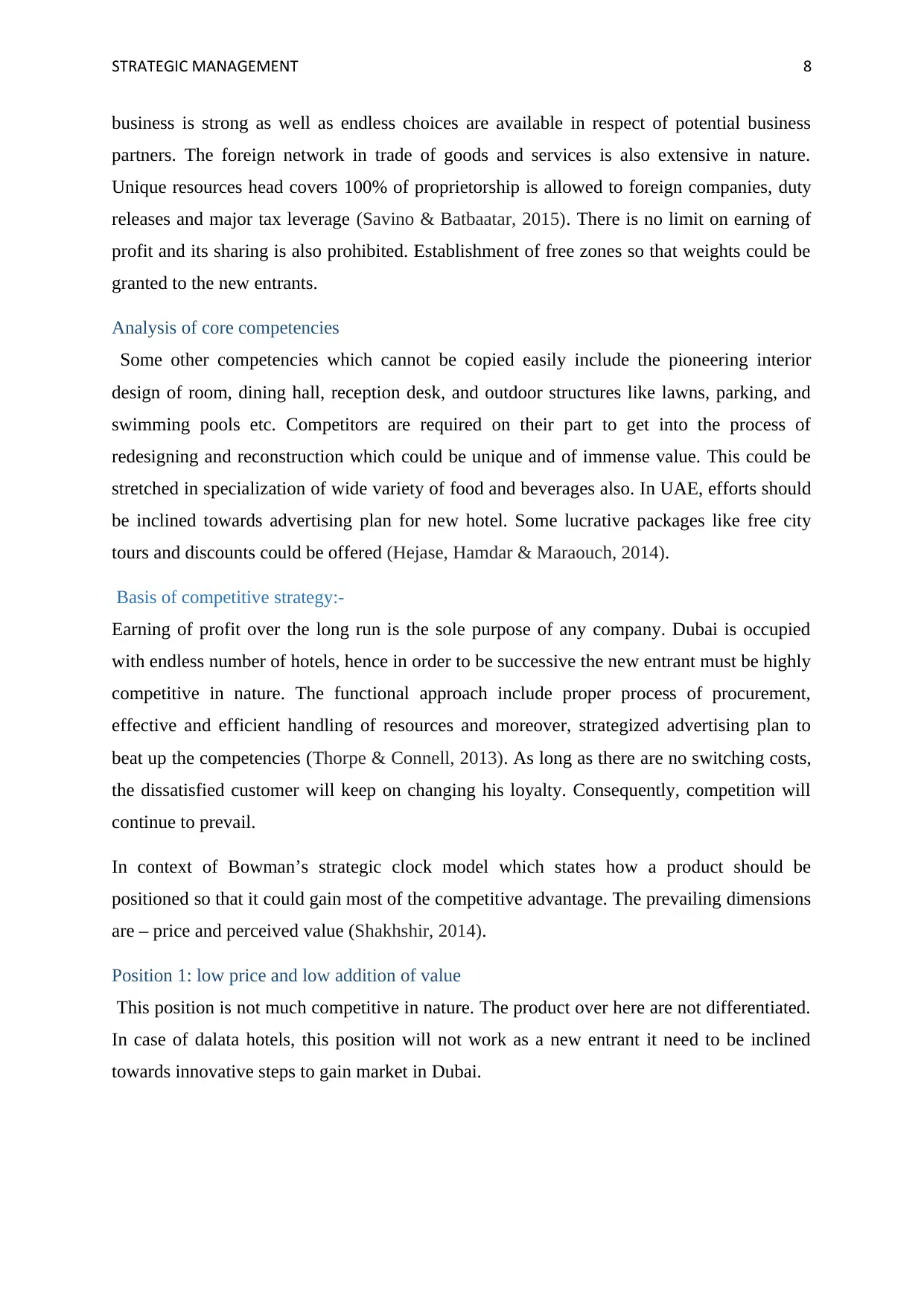
STRATEGIC MANAGEMENT 8
business is strong as well as endless choices are available in respect of potential business
partners. The foreign network in trade of goods and services is also extensive in nature.
Unique resources head covers 100% of proprietorship is allowed to foreign companies, duty
releases and major tax leverage (Savino & Batbaatar, 2015). There is no limit on earning of
profit and its sharing is also prohibited. Establishment of free zones so that weights could be
granted to the new entrants.
Analysis of core competencies
Some other competencies which cannot be copied easily include the pioneering interior
design of room, dining hall, reception desk, and outdoor structures like lawns, parking, and
swimming pools etc. Competitors are required on their part to get into the process of
redesigning and reconstruction which could be unique and of immense value. This could be
stretched in specialization of wide variety of food and beverages also. In UAE, efforts should
be inclined towards advertising plan for new hotel. Some lucrative packages like free city
tours and discounts could be offered (Hejase, Hamdar & Maraouch, 2014).
Basis of competitive strategy:-
Earning of profit over the long run is the sole purpose of any company. Dubai is occupied
with endless number of hotels, hence in order to be successive the new entrant must be highly
competitive in nature. The functional approach include proper process of procurement,
effective and efficient handling of resources and moreover, strategized advertising plan to
beat up the competencies (Thorpe & Connell, 2013). As long as there are no switching costs,
the dissatisfied customer will keep on changing his loyalty. Consequently, competition will
continue to prevail.
In context of Bowman’s strategic clock model which states how a product should be
positioned so that it could gain most of the competitive advantage. The prevailing dimensions
are – price and perceived value (Shakhshir, 2014).
Position 1: low price and low addition of value
This position is not much competitive in nature. The product over here are not differentiated.
In case of dalata hotels, this position will not work as a new entrant it need to be inclined
towards innovative steps to gain market in Dubai.
business is strong as well as endless choices are available in respect of potential business
partners. The foreign network in trade of goods and services is also extensive in nature.
Unique resources head covers 100% of proprietorship is allowed to foreign companies, duty
releases and major tax leverage (Savino & Batbaatar, 2015). There is no limit on earning of
profit and its sharing is also prohibited. Establishment of free zones so that weights could be
granted to the new entrants.
Analysis of core competencies
Some other competencies which cannot be copied easily include the pioneering interior
design of room, dining hall, reception desk, and outdoor structures like lawns, parking, and
swimming pools etc. Competitors are required on their part to get into the process of
redesigning and reconstruction which could be unique and of immense value. This could be
stretched in specialization of wide variety of food and beverages also. In UAE, efforts should
be inclined towards advertising plan for new hotel. Some lucrative packages like free city
tours and discounts could be offered (Hejase, Hamdar & Maraouch, 2014).
Basis of competitive strategy:-
Earning of profit over the long run is the sole purpose of any company. Dubai is occupied
with endless number of hotels, hence in order to be successive the new entrant must be highly
competitive in nature. The functional approach include proper process of procurement,
effective and efficient handling of resources and moreover, strategized advertising plan to
beat up the competencies (Thorpe & Connell, 2013). As long as there are no switching costs,
the dissatisfied customer will keep on changing his loyalty. Consequently, competition will
continue to prevail.
In context of Bowman’s strategic clock model which states how a product should be
positioned so that it could gain most of the competitive advantage. The prevailing dimensions
are – price and perceived value (Shakhshir, 2014).
Position 1: low price and low addition of value
This position is not much competitive in nature. The product over here are not differentiated.
In case of dalata hotels, this position will not work as a new entrant it need to be inclined
towards innovative steps to gain market in Dubai.
⊘ This is a preview!⊘
Do you want full access?
Subscribe today to unlock all pages.

Trusted by 1+ million students worldwide
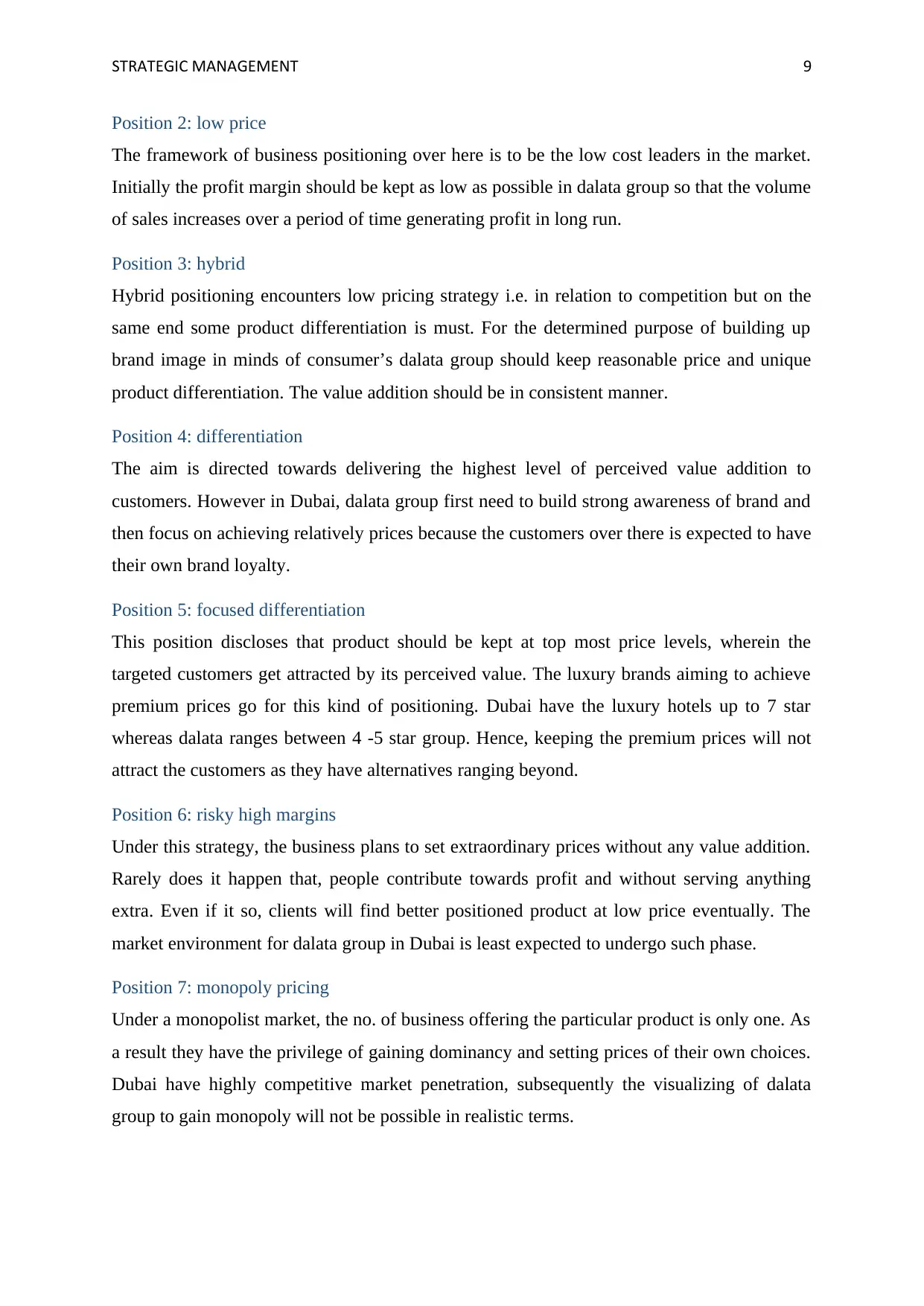
STRATEGIC MANAGEMENT 9
Position 2: low price
The framework of business positioning over here is to be the low cost leaders in the market.
Initially the profit margin should be kept as low as possible in dalata group so that the volume
of sales increases over a period of time generating profit in long run.
Position 3: hybrid
Hybrid positioning encounters low pricing strategy i.e. in relation to competition but on the
same end some product differentiation is must. For the determined purpose of building up
brand image in minds of consumer’s dalata group should keep reasonable price and unique
product differentiation. The value addition should be in consistent manner.
Position 4: differentiation
The aim is directed towards delivering the highest level of perceived value addition to
customers. However in Dubai, dalata group first need to build strong awareness of brand and
then focus on achieving relatively prices because the customers over there is expected to have
their own brand loyalty.
Position 5: focused differentiation
This position discloses that product should be kept at top most price levels, wherein the
targeted customers get attracted by its perceived value. The luxury brands aiming to achieve
premium prices go for this kind of positioning. Dubai have the luxury hotels up to 7 star
whereas dalata ranges between 4 -5 star group. Hence, keeping the premium prices will not
attract the customers as they have alternatives ranging beyond.
Position 6: risky high margins
Under this strategy, the business plans to set extraordinary prices without any value addition.
Rarely does it happen that, people contribute towards profit and without serving anything
extra. Even if it so, clients will find better positioned product at low price eventually. The
market environment for dalata group in Dubai is least expected to undergo such phase.
Position 7: monopoly pricing
Under a monopolist market, the no. of business offering the particular product is only one. As
a result they have the privilege of gaining dominancy and setting prices of their own choices.
Dubai have highly competitive market penetration, subsequently the visualizing of dalata
group to gain monopoly will not be possible in realistic terms.
Position 2: low price
The framework of business positioning over here is to be the low cost leaders in the market.
Initially the profit margin should be kept as low as possible in dalata group so that the volume
of sales increases over a period of time generating profit in long run.
Position 3: hybrid
Hybrid positioning encounters low pricing strategy i.e. in relation to competition but on the
same end some product differentiation is must. For the determined purpose of building up
brand image in minds of consumer’s dalata group should keep reasonable price and unique
product differentiation. The value addition should be in consistent manner.
Position 4: differentiation
The aim is directed towards delivering the highest level of perceived value addition to
customers. However in Dubai, dalata group first need to build strong awareness of brand and
then focus on achieving relatively prices because the customers over there is expected to have
their own brand loyalty.
Position 5: focused differentiation
This position discloses that product should be kept at top most price levels, wherein the
targeted customers get attracted by its perceived value. The luxury brands aiming to achieve
premium prices go for this kind of positioning. Dubai have the luxury hotels up to 7 star
whereas dalata ranges between 4 -5 star group. Hence, keeping the premium prices will not
attract the customers as they have alternatives ranging beyond.
Position 6: risky high margins
Under this strategy, the business plans to set extraordinary prices without any value addition.
Rarely does it happen that, people contribute towards profit and without serving anything
extra. Even if it so, clients will find better positioned product at low price eventually. The
market environment for dalata group in Dubai is least expected to undergo such phase.
Position 7: monopoly pricing
Under a monopolist market, the no. of business offering the particular product is only one. As
a result they have the privilege of gaining dominancy and setting prices of their own choices.
Dubai have highly competitive market penetration, subsequently the visualizing of dalata
group to gain monopoly will not be possible in realistic terms.
Paraphrase This Document
Need a fresh take? Get an instant paraphrase of this document with our AI Paraphraser
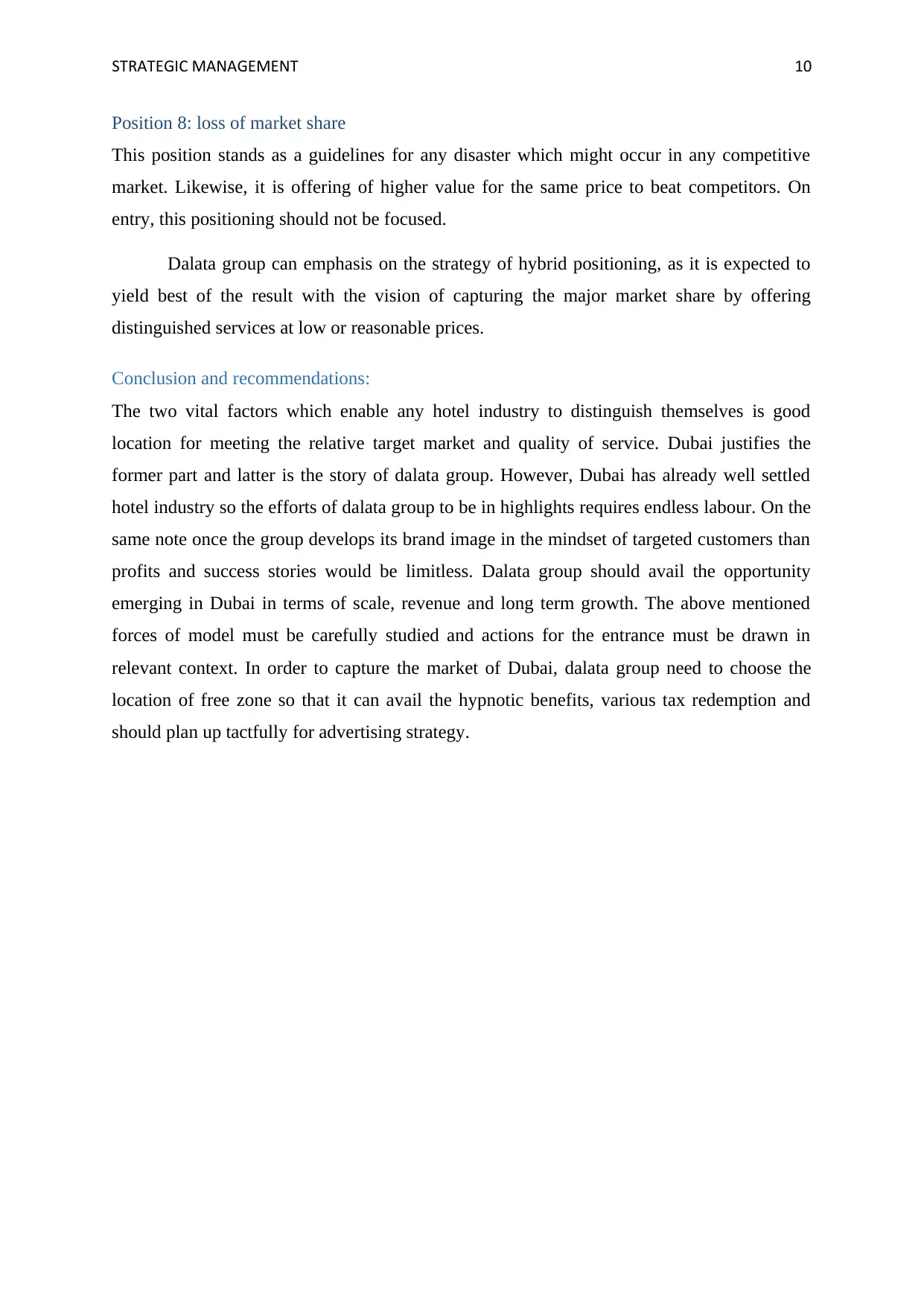
STRATEGIC MANAGEMENT 10
Position 8: loss of market share
This position stands as a guidelines for any disaster which might occur in any competitive
market. Likewise, it is offering of higher value for the same price to beat competitors. On
entry, this positioning should not be focused.
Dalata group can emphasis on the strategy of hybrid positioning, as it is expected to
yield best of the result with the vision of capturing the major market share by offering
distinguished services at low or reasonable prices.
Conclusion and recommendations:
The two vital factors which enable any hotel industry to distinguish themselves is good
location for meeting the relative target market and quality of service. Dubai justifies the
former part and latter is the story of dalata group. However, Dubai has already well settled
hotel industry so the efforts of dalata group to be in highlights requires endless labour. On the
same note once the group develops its brand image in the mindset of targeted customers than
profits and success stories would be limitless. Dalata group should avail the opportunity
emerging in Dubai in terms of scale, revenue and long term growth. The above mentioned
forces of model must be carefully studied and actions for the entrance must be drawn in
relevant context. In order to capture the market of Dubai, dalata group need to choose the
location of free zone so that it can avail the hypnotic benefits, various tax redemption and
should plan up tactfully for advertising strategy.
Position 8: loss of market share
This position stands as a guidelines for any disaster which might occur in any competitive
market. Likewise, it is offering of higher value for the same price to beat competitors. On
entry, this positioning should not be focused.
Dalata group can emphasis on the strategy of hybrid positioning, as it is expected to
yield best of the result with the vision of capturing the major market share by offering
distinguished services at low or reasonable prices.
Conclusion and recommendations:
The two vital factors which enable any hotel industry to distinguish themselves is good
location for meeting the relative target market and quality of service. Dubai justifies the
former part and latter is the story of dalata group. However, Dubai has already well settled
hotel industry so the efforts of dalata group to be in highlights requires endless labour. On the
same note once the group develops its brand image in the mindset of targeted customers than
profits and success stories would be limitless. Dalata group should avail the opportunity
emerging in Dubai in terms of scale, revenue and long term growth. The above mentioned
forces of model must be carefully studied and actions for the entrance must be drawn in
relevant context. In order to capture the market of Dubai, dalata group need to choose the
location of free zone so that it can avail the hypnotic benefits, various tax redemption and
should plan up tactfully for advertising strategy.
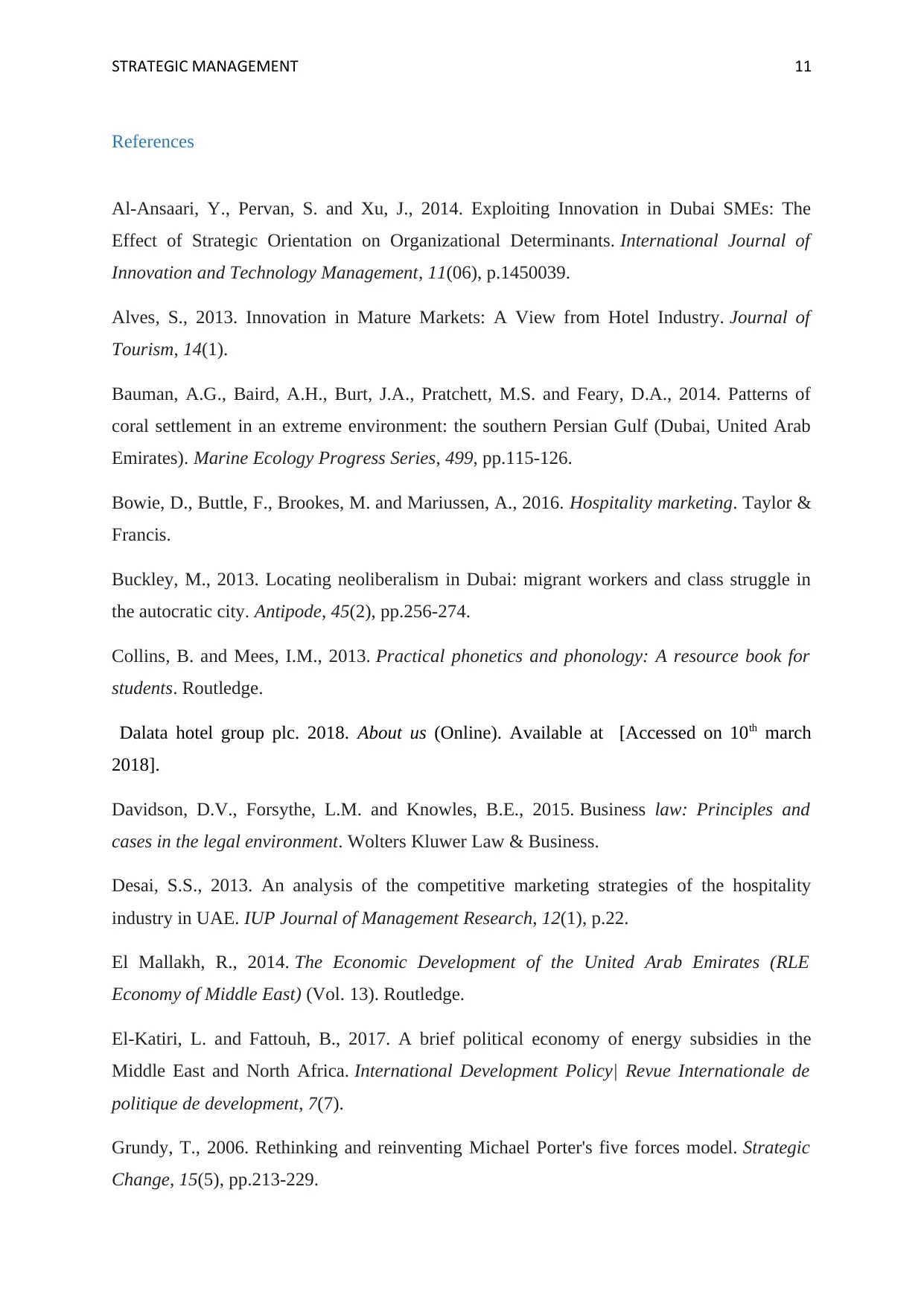
STRATEGIC MANAGEMENT 11
References
Al-Ansaari, Y., Pervan, S. and Xu, J., 2014. Exploiting Innovation in Dubai SMEs: The
Effect of Strategic Orientation on Organizational Determinants. International Journal of
Innovation and Technology Management, 11(06), p.1450039.
Alves, S., 2013. Innovation in Mature Markets: A View from Hotel Industry. Journal of
Tourism, 14(1).
Bauman, A.G., Baird, A.H., Burt, J.A., Pratchett, M.S. and Feary, D.A., 2014. Patterns of
coral settlement in an extreme environment: the southern Persian Gulf (Dubai, United Arab
Emirates). Marine Ecology Progress Series, 499, pp.115-126.
Bowie, D., Buttle, F., Brookes, M. and Mariussen, A., 2016. Hospitality marketing. Taylor &
Francis.
Buckley, M., 2013. Locating neoliberalism in Dubai: migrant workers and class struggle in
the autocratic city. Antipode, 45(2), pp.256-274.
Collins, B. and Mees, I.M., 2013. Practical phonetics and phonology: A resource book for
students. Routledge.
Dalata hotel group plc. 2018. About us (Online). Available at [Accessed on 10th march
2018].
Davidson, D.V., Forsythe, L.M. and Knowles, B.E., 2015. Business law: Principles and
cases in the legal environment. Wolters Kluwer Law & Business.
Desai, S.S., 2013. An analysis of the competitive marketing strategies of the hospitality
industry in UAE. IUP Journal of Management Research, 12(1), p.22.
El Mallakh, R., 2014. The Economic Development of the United Arab Emirates (RLE
Economy of Middle East) (Vol. 13). Routledge.
El-Katiri, L. and Fattouh, B., 2017. A brief political economy of energy subsidies in the
Middle East and North Africa. International Development Policy| Revue Internationale de
politique de development, 7(7).
Grundy, T., 2006. Rethinking and reinventing Michael Porter's five forces model. Strategic
Change, 15(5), pp.213-229.
References
Al-Ansaari, Y., Pervan, S. and Xu, J., 2014. Exploiting Innovation in Dubai SMEs: The
Effect of Strategic Orientation on Organizational Determinants. International Journal of
Innovation and Technology Management, 11(06), p.1450039.
Alves, S., 2013. Innovation in Mature Markets: A View from Hotel Industry. Journal of
Tourism, 14(1).
Bauman, A.G., Baird, A.H., Burt, J.A., Pratchett, M.S. and Feary, D.A., 2014. Patterns of
coral settlement in an extreme environment: the southern Persian Gulf (Dubai, United Arab
Emirates). Marine Ecology Progress Series, 499, pp.115-126.
Bowie, D., Buttle, F., Brookes, M. and Mariussen, A., 2016. Hospitality marketing. Taylor &
Francis.
Buckley, M., 2013. Locating neoliberalism in Dubai: migrant workers and class struggle in
the autocratic city. Antipode, 45(2), pp.256-274.
Collins, B. and Mees, I.M., 2013. Practical phonetics and phonology: A resource book for
students. Routledge.
Dalata hotel group plc. 2018. About us (Online). Available at [Accessed on 10th march
2018].
Davidson, D.V., Forsythe, L.M. and Knowles, B.E., 2015. Business law: Principles and
cases in the legal environment. Wolters Kluwer Law & Business.
Desai, S.S., 2013. An analysis of the competitive marketing strategies of the hospitality
industry in UAE. IUP Journal of Management Research, 12(1), p.22.
El Mallakh, R., 2014. The Economic Development of the United Arab Emirates (RLE
Economy of Middle East) (Vol. 13). Routledge.
El-Katiri, L. and Fattouh, B., 2017. A brief political economy of energy subsidies in the
Middle East and North Africa. International Development Policy| Revue Internationale de
politique de development, 7(7).
Grundy, T., 2006. Rethinking and reinventing Michael Porter's five forces model. Strategic
Change, 15(5), pp.213-229.
⊘ This is a preview!⊘
Do you want full access?
Subscribe today to unlock all pages.

Trusted by 1+ million students worldwide
1 out of 15
Related Documents
Your All-in-One AI-Powered Toolkit for Academic Success.
+13062052269
info@desklib.com
Available 24*7 on WhatsApp / Email
![[object Object]](/_next/static/media/star-bottom.7253800d.svg)
Unlock your academic potential
Copyright © 2020–2025 A2Z Services. All Rights Reserved. Developed and managed by ZUCOL.





